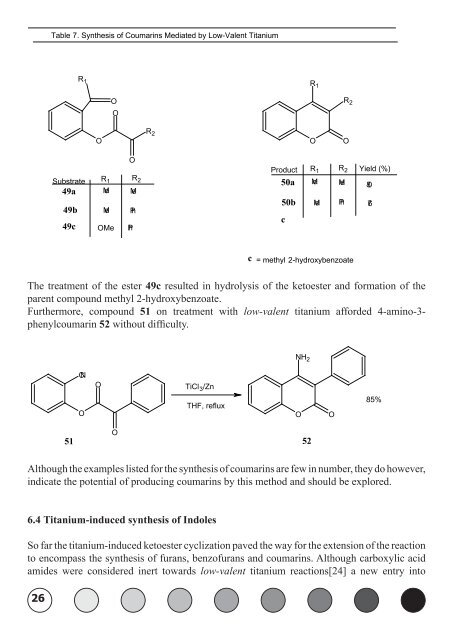Low-Valent Titanium Induced Carbonyl Coupling Reactions
Low-Valent Titanium Induced Carbonyl Coupling Reactions
Low-Valent Titanium Induced Carbonyl Coupling Reactions
Create successful ePaper yourself
Turn your PDF publications into a flip-book with our unique Google optimized e-Paper software.
26<br />
Table 7. Synthesis of Coumarins Mediated by <strong>Low</strong>-<strong>Valent</strong> <strong>Titanium</strong><br />
R 1<br />
Substrate<br />
49a<br />
49b<br />
O<br />
R 1<br />
O<br />
O<br />
O<br />
Me Me<br />
Me Ph<br />
49c OMe Ph<br />
R 2<br />
R 2<br />
c<br />
Product<br />
50a<br />
50b<br />
c<br />
R 1<br />
R 2<br />
O O<br />
R 1<br />
R 2<br />
Me Me<br />
Me<br />
Ph<br />
= methyl 2-hydroxybenzoate<br />
Yield (%)<br />
The treatment of the ester 49c resulted in hydrolysis of the ketoester and formation of the<br />
parent compound methyl 2-hydroxybenzoate.<br />
Furthermore, compound 51 on treatment with low-valent titanium afforded 4-amino-3phenylcoumarin<br />
52 without difficulty.<br />
CN<br />
O<br />
O<br />
TiCl 3/Zn<br />
THF, reflux<br />
NH 2<br />
O<br />
51 52<br />
Although the examples listed for the synthesis of coumarins are few in number, they do however,<br />
indicate the potential of producing coumarins by this method and should be explored.<br />
6.4 <strong>Titanium</strong>-induced synthesis of Indoles<br />
So far the titanium-induced ketoester cyclization paved the way for the extension of the reaction<br />
to encompass the synthesis of furans, benzofurans and coumarins. Although carboxylic acid<br />
amides were considered inert towards low-valent titanium reactions[24] a new entry into<br />
O<br />
O<br />
80<br />
76<br />
85%










